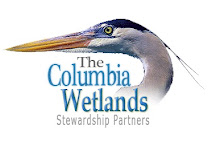
Fire flies are one of the most interesting and spectacular insects on the planet. They glow in the dark on warm June evenings, flitting back and forth and flashing tiny lights in the night. Fireflies are actually beetles. They create their "fire" by mixing oxygen with chemicals called luciferin and luciferase in their abdomen, which creates light without any heat. Each species of firefly has a unique flash pattern, which they use to attract mates. Fireflies are apparently in decline around the planet; in many places as a result of the presence of artificial light which somehow alters their mating behavior. There are about 2,000 firefly species around the planet, with 170 species found in the United States, almost all of which are found east of the Mississippi River and are a familiar sight on summer evenings in the south east states and parts of eastern Canada.
They are very uncommon however, in our valley. Members of the Columbia Wetlands Stewardship Partners have recently found this rare critter in several places in the valley. With support from Parks Canada, the Royal BC Museum and a bunch of volunteers, they are trying to figure out exactly where they live and what their habitat requirements are here in the Trench.
Bob Jamieson, the Executive Director for the Wetland Partners said: "Fire flies are a wonderful symbol of healthy wetlands, and a their mating display is a very special thing to show young people to introduce them to the magic of wetlands and natural systems. To go down to a wetland in the dark and see their amazing light display was a life changing event for me as a child, and we want to continue to provide kids here with the opportunity for having that same experience".
The Wetland Partners will be working this spring Rob Cannings and a bunch of local biologists and land owners, to figure out exactly where they live and what their habitat requirements are. The species found here is probablyPhoturis pennsylvanica, according to Rob Cannings. Rob has found two species in B.C., one in the East Kootenays and one in the genue Photinus, in the central interior north into the Peace River country.
"We have found them in several places in the Kootenay drainage, and at 3 places in the Columbia wetlands", says Bob. "We know they occur, or occurred until recently, in the Hahas Lake area south of Cranbrook, near Fort Steele, at Bull River town, at Bummer's Flats, near Wasa Lake and at Ta Ta Lake in behind Ta Ta Creek. Decades ago they also lived along the Lussier River, but don't seem to occur there now. They have also been seen, years ago, around Cranbrook, at the old drive-in theatre. Further north they are found in the wetlands along the south edge of Columbia Lake near Canal Flats, at Luxor Creek, in the Brisco area and in some of the pothole lakes on the west side benches south of the Spillimacheen River (Cub and Butts Lakes). They used to occur near the old springs at Fairmont Hot Springs and at Windermere. We are going to look at these sites over the next few weeks to see if we can find them at these places.
We would also like to ask everyone who is reading your paper, to think back and see if they can remember seeing them at these places, or in other parts of the valley. If you have seen them, please give us a call."The ranchers and farmers in the valley tend to be the ones who see them, since they are out in the middle of the night on hot summer evenings, either fixing irrigation or haying. They are the ones who have provided most of the observations we have to date.
Their preferred habitat is a wetland area with lots of cattails, associated with a permanent spring that stays open through the winter. Apparently they feed on small snails that live in these kinds of habitat. In the East Kootenays,observations to date suggest that they use pothole wetlands (Hahas, Ta Ta, Butts, Cub Lakes) on the benches of the valley and the wetlands along the major rivers.
"We have been calling around to land owners and ranchers up and down the valley and it has been surprising how interested everyone is in this little, but spectacular critter", says Bob. In the Brisco area, they are a part of local history. Apparently back in the 50's one of the local farmers ran a moonshine still that was hidden down on the edge of the wetlands. All the local gents would gather at the still after dark and sip shine and look out into the night over the wetlands. And see little lights bouncing all over the place. Paul Galbraith, a local rancher now, used to go down to the still as a kid, with his dad. "And I saw the lights in the marsh, even though they wouldn't let me drink the shine!"
There are a couple of websites dedicated to fire flies at if you are interested in learning more: www.firefly.org and http://iris.biosci.ohio-state.edu/projects/FFiles/frfact.html
One of the outcomes of this work will be to identify places where we can take young kids in the future and show them these amazing displays and give the next generation of kids here a sense of the magic that wetlands provide in our valley.
If you have seen fire flies, especially if you have seen them in places not listed above, please give us a call. We are very interested in your stories.
Please call:
Bob Jamieson
Exec. Director
Col. Wetland Stewardship Partners
250-422-3322
bjamieson@cintek.com










